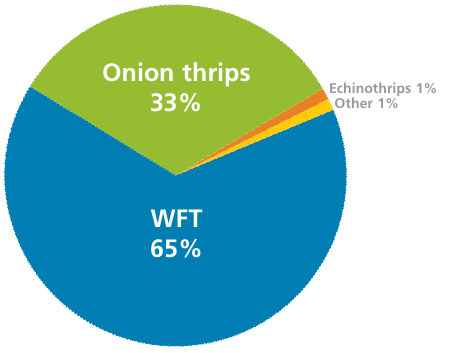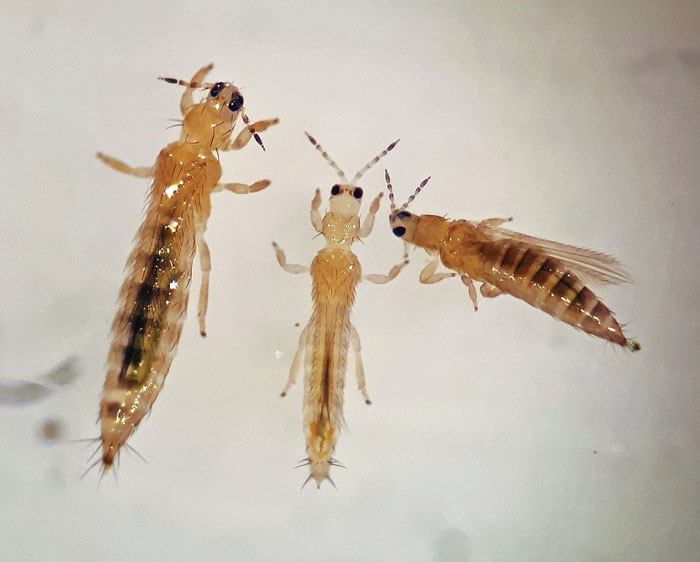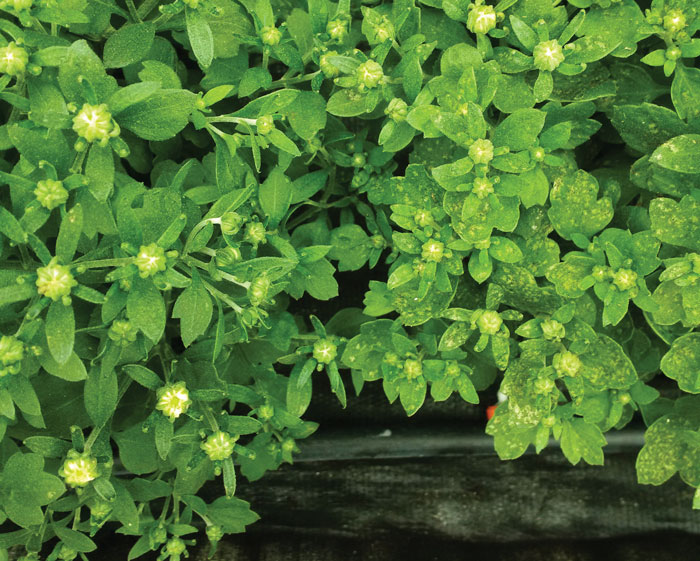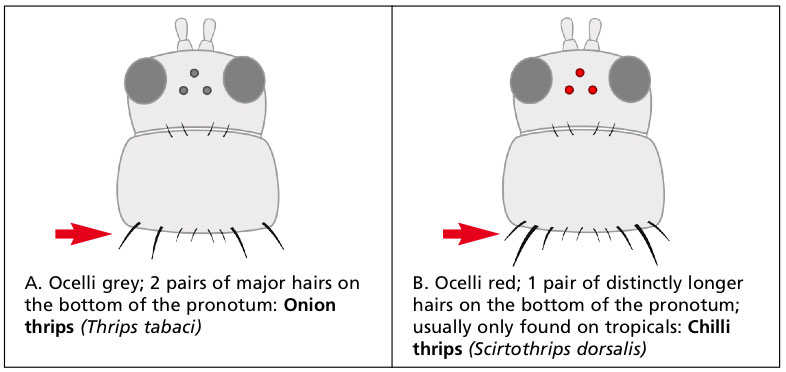5/1/2019
Thwarted by Thrips? This Could be Why.
Dr. Sarah Jandricic
Like many floriculture-producing areas of the U.S., Ontario has a long history of using biological control against thrips. The use of predatory mites, along with foliar applications of Beauveria and drenches of nematodes, generally manages thrips in most crops. However, for the last few years, astute growers and consultants have noticed that thrips biocontrol programs don’t seem to be working as well as they used to. More sudden and serious outbreaks are occurring, leading to losses from heavy foliar feeding damage, which begs the question: why the sudden breakdown in thrips biocontrol? And can this affect growers outside of Ontario?
To answer this question, the first step was to look at the quality of predatory mites (both cucumeris and swirskii) in mite sachet-based thrips control programs to see if anything had changed. Besides noticing a few easy-to-make mistakes post-receipt (e.g., improper storage or placement of sachets in the crop, either of which can reduce effectiveness), the quality of our bios is generally not the issue here.
If it isn’t the bios, could it be the pest that was different? In Ontario, like most floriculture production areas, we’ve been under the impression that Western flower thrips (WFT, Frankliniella occidentalis) is generally the only thrips of concern, except for Echinothrips (Echinothrips americanus) in a few crops like poinsettia and cut gerbera. But no study had been done to confirm this, so a team of undergraduates and I collected thrips from several large commercial floriculture operations in Southern Ontario from May to August 2016 and from two nearby operations in 2017.
Onion thrips: A reason to cry?
Our survey results surprised us. Although WFT were the primary thrips species present, they certainly weren’t the only one (Figure 1). Over 30% of thrips sampled were a species normally of concern in field crops, not floriculture: onion thrips (OT, Thrips tabaci). We found OT in many crops, but ratios were highest in gerbera and mums (both potted and cut). We’ve also been seeing recent outbreaks in other plant species, such as passion flower, osteospermum and gloxinia (again, even when good coverage of typical thrips bios were used).
 Figure 1. Average percentage of different thrips species found across eight large Ontario floriculture operations. Crops sampled included mums and gerbera (both potted and cut), geranium, mandevilla, impatiens and hibiscus. Onion thrips levels were highest in mums and gerbera (up to 65% of thrips present).
Figure 1. Average percentage of different thrips species found across eight large Ontario floriculture operations. Crops sampled included mums and gerbera (both potted and cut), geranium, mandevilla, impatiens and hibiscus. Onion thrips levels were highest in mums and gerbera (up to 65% of thrips present).
Within individual greenhouses, we also saw that the ratio of OT can vary drastically year to year. One of our sample locations had 20% OT in their mum crop in summer 2016, but in summer 2017, this was over 65% and they were seeing damage. Monitoring throughout 2018/2019 has shown that OT can take up residence in floriculture greenhouses throughout winter and remain the primary thrips pest.
Once we understood the culprit behind these biocontrol failures, we reached out to some of our U.S. counterparts to see if they were seeing the same thing. Consultants in the U.S. have confirmed that onion thrips are being seen in floriculture greenhouses there, although the extent of the problem is currently unknown.
 Figure 2. Western flower thrips (WFT) and onion thrips are difficult to tell apart without a microscope. From left to right: Female WFT, male WFT, female onion thrips (Thrips tabaci). Photo courtesy of A. Summerfield.
Figure 2. Western flower thrips (WFT) and onion thrips are difficult to tell apart without a microscope. From left to right: Female WFT, male WFT, female onion thrips (Thrips tabaci). Photo courtesy of A. Summerfield.
So how can you know if OT is affecting your crop? OT looks very similar to WFT (they’re pretty much impossible to differentiate with just a hand lens; see Figure 2), which is why its presence has likely gone unnoticed until now. But we’ve noticed some tell-tale signs that can tip you off that this pest is mucking up your thrips biocontrol program:
1. Intensive foliar damage, which seems to be characteristic of this pest. WFT, on the other hand, seem to prefer blooms.
2. Damage is often clustered in small groups of plants (Figure 3), with plants nearby seemingly unaffected (suggesting they aggregate more than WFT).
3. Thrips in the crop, but not on monitoring cards. This suggests that OT may fly around less than WFT. Although, in heavy infestations, we’ve noted that large yellow mass trapping cards can help trap both species of thrips.
4. Limited effectiveness of “typical” thrips biocontrol programs, particularly when using primarily Amblyseius cucumeris mites for control.
5. Unlike WFT, OT responds to chemical controls. This includes broad spectrum chemicals like Pylon (clorfenapyr), as well as “softer” chemicals such as Success (spinosad) that don’t work for the highly pesticide-resistant WFT.
 Figure 3. Heavy foliar feeding damage from onion thrips (right) next to an undamaged plant (left). Tightly clustered damaged seems to be a characteristic of this pest.
Figure 3. Heavy foliar feeding damage from onion thrips (right) next to an undamaged plant (left). Tightly clustered damaged seems to be a characteristic of this pest.
Ultimately, it’s best to confirm any suspected case of OT by sending samples of adult thrips from plant taps to your local extension agent or diagnostic lab for proper identification. If you have access to a microscope and some patience, you can also use the simplified, picture-based identification key (Figure 4) developed by myself and Ashley Summerfield, Biocontrol Technician at the Vineland Research and Innovation Centre. This key to common greenhouse pest thrips, developed specifically for floriculture growers/consultants, can be found on the ONFloriculture blog (ONfloriculture.wordpress.com) under “Grower Tools” on the side menu.
Although we have tools to identify them and potential chemicals to control them (depending on registrations in your area), there’s still a lot to be understood about OT as a pest in floriculture crops. First, why are they just becoming a problem? It may have to do with reduced/eliminated pesticide use in biocontrol-based operations, allowing OT to emerge as a “secondary” pest. Outside pressures from field sites resulting in greater numbers of OT entering greenhouses might also play a role.
 Figure 4. Example of the simplified pictorial key growers and consultants can use to identify major thrips species in floriculture greenhouses. Requires a microscope of 40x. This key can be found on ONFloriculture.wordpress.com under "Grower Tools."
Figure 4. Example of the simplified pictorial key growers and consultants can use to identify major thrips species in floriculture greenhouses. Requires a microscope of 40x. This key can be found on ONFloriculture.wordpress.com under "Grower Tools."
Second, we need to understand which biocontrol measures currently used for thrips control are—and are not—effective for OT specifically. This will help us develop a comprehensive biocontrol program for multiple thrips species in floriculture. A joint venture by OMAFRA, academic and industry partners are planning in-depth studies for 2019.
Until then, greenhouses with high or recurring populations of OT may need to look to more traditional IPM programs for thrips control. Chemical applications may be needed to reduce the number of OT on “hot spots,” sensitive crops or plants close to shipping. Post-spray, normal biocontrol programs for remaining WFT can be resumed, depending on the pesticide residual.
Ratios of OT to WFT should be monitored regularly with plant taps to determine if sprays are needed, since the use of potentially unnecessary “diagnostic sprays” could lead to insecticide resistance in OT, much like in WFT. GT
Sarah Jandricic (sarah.jandricic@ontario.ca) is the Greenhouse Floriculture IPM Specialist for the Ontario Ministry of Agriculture, Food and Rural Affairs (OMAFRA) in Canada. She runs the ONFloriculture blog, which provides timely pest management information to floriculture growers.